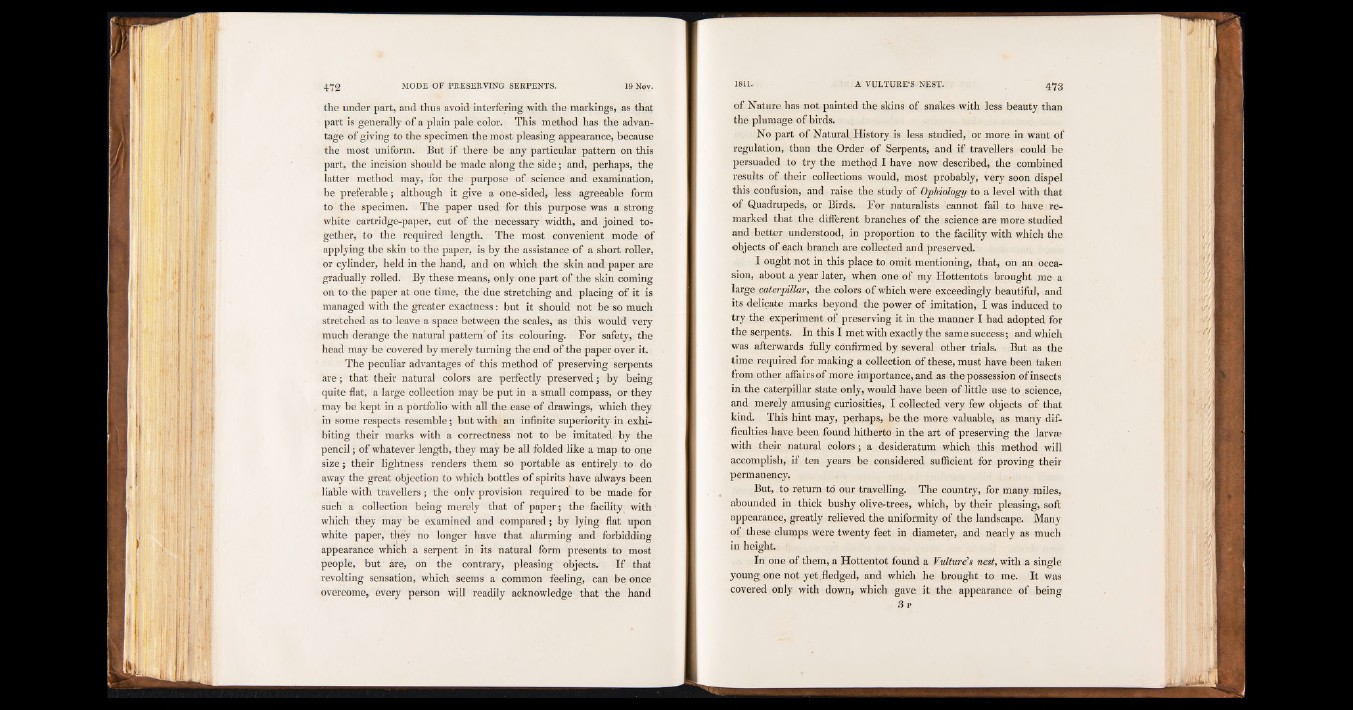
the under part, and thus avoid interfering with the markings, as that
part is generally of a plain pale color. This method has the advantage
of giving to the specimen the most pleasing appearance, because
the most uniform. But if there be any particular pattern on this
part, the incision should be made along the side; and, perhaps, the
latter method may, for the purpose of science and examination,
be preferable; although it give a one-sided, less agreeable form
to the specimen. The paper used for this purpose was a strong
white cartridge-paper, cut of the necessary width, and joined together,
to the required length. The most convenient mode of
applying the skin to the paper, is by the assistance of a short roller,
or cylinder, held in the hand, and on which the skin and paper are
gradually rolled. By these means, only one part of the skin coming
on to the paper at one time, the due stretching and placing of it is
managed with the greater exactness: but it should not be so much
stretched as to leave a space between the scales, as this would very
much derange the natural pattern of its colouring. For safety, the
head may be covered by merely turning the end of the paper over it.
The peculiar advantages of this method of preserving serpents
á re ; that their natural colors are perfectly preserved; by being
quite flat, a large collection may be put in a small compass, or they
may be kept in a portfolio with all the ease of drawings, which they
in some respects resemble; but with an infinite superiority in exhibiting
their marks with a correctness not to be imitated by the
pencil; of whatever length, they may be all folded like a map to one
size; their lightness renders them so portable as entirely to do
away the great objection to which bottles of spirits have always been
liable with travellers; the only provision required to be made for
such a collection being merely that of paper; the facility with
which they may be examined and compared; by lying flat upon
white paper, they no longer have that alarming and forbidding
appearance which a serpent in its natural form presents to most
people, but áre, on the contrary, pleasing objects. If that
revolting sensation, which seems a common feeling, can be once
overcome, every person will readily acknowledge that the hand
of Nature has not painted the skins of snakes with less beauty than
the plumage of birds.
No part of Natural History is less studied, or more in want of
regulation, than the Order of Serpents, and if travellers could be
persuaded to try the method I have now described, the combined
results of their collections would, most probably, very soon dispel
this confusion, and raise the study of Ophiology to a level with that
of Quadrupeds, or Birds. For naturalists cannot fail to have remarked
that the different branches of the science are more studied
and better understood, in proportion to the facility with which the
objects of each branch are collected and preserved.
I ought not in this place to omit mentioning, that, on an occasion,
about a year later, when one of my Hottentots brought me a
large caterpillar, the colors of which were exceedingly beautiful, and
its delicate marks beyond the power of imitation, I was induced to
try the experiment of preserving it in the manner I had adopted for
the serpentjs. In this I met with exactly the same success; and which
was afterwards fully confirmed by several other trials. But as the
time required for making a collection of these, must have been taken
from other affairs of more importance, and as the possession of insects
in the caterpillar state only, would have been of little use to science,
and merely amusing curiosities, I collected very few objects of that
kind. This hint may, perhaps, be the more valuable, as many difficulties
have been found hitherto in the art of preserving the larvae
with their natural colors; a desideratum which this method will
accomplish, if ten years be considered sufficient for proving their
permanency.
But, to return to our travelling. The country, for many miles,
abounded in thick bushy olive-trees, which, by their pleasing, soft
appearance, greatly relieved the uniformity of the landscape. Many
of these clumps were twenty feet in diameter, and nearly as much
in height.
In one of them, a Hottentot found a Vultures nest, with a single
young one not yet.fledged, and which he brought to me. It was
covered only with down, which gave it the appearance of being
3 p